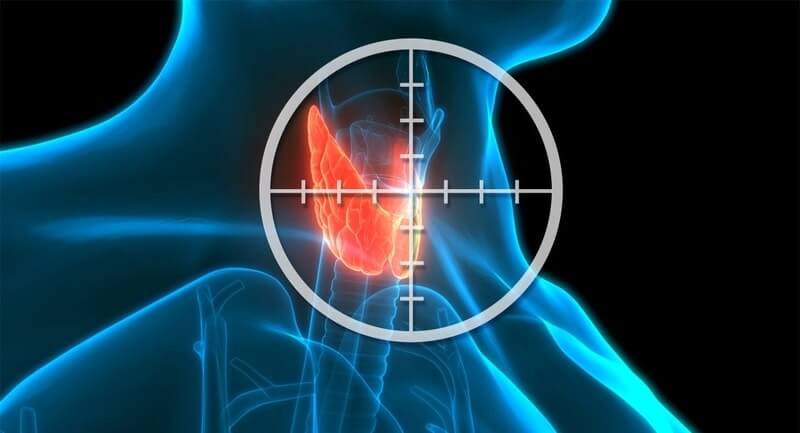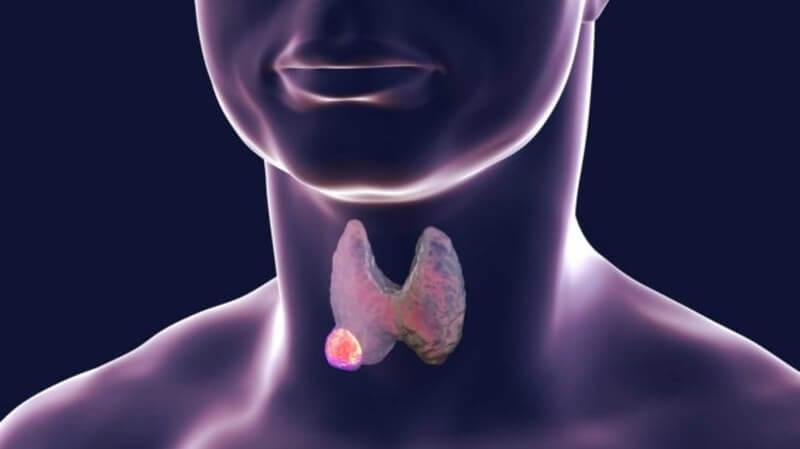Thyroid tumors are divided into several types, in which papilloma thyroid tumors are quite common types of thyroid cancer today. Although the disease progresses slowly and has a good prognosis. However, the lack of early recognition of signs of the disease leads to many cases when new metastatic papilloma cancers are discovered, making treatment difficult.
Therefore, having a better understanding of this pathology is how we can proactively protect our health from the very beginning, avoiding the serious consequences caused by the disease.
What Is Papillary Thyroid Carcinoma?
What is papillary thyroid carcinoma? Papillary thyroid cancer is a thyroid disease, also known as papillary carcinoma, which is also the best-differentiated form of thyroid cancer.
Not only that, for this pathology often the main cause is that the patient is exposed to radiation for a long time.
For papillary thyroid tumors, which usually appear as nodules or as cysts of irregular sizes, it is possible that tumors appear in normal thyroid parenchyma.

When the disease is late detected and advanced, these papillary carcinomas may have begun to have minimal or overly invasive attacks that affect other organs.
In fact, there have been many cases of papillary thyroid cancers, which have invaded other organs, even the lymphatic system, but very few have invaded the blood vessels.
For the diagnosis of papillary thyroid tumors, small needle aspiration biopsy is the first and most commonly used diagnostic method in the event that a doctor discovers a suspected thyroid nodule or tumor. cancer.
In this case, for good intervention and control, if it is a papilloma thyroid tumor, the doctor may prescribe the patient needing radical surgery.
Next, for the next 4-6 weeks after the thyroidectomy, the patient will likely have to continue additional treatment with radioactive iodine in order to detect and destroy the metastatic cells and malignant tissue that remain inside the thyroid gland.
The prognosis of a patient diagnosed with a papillary thyroid tumor is often very dependent on age. Accordingly, the future outlook in young patients will be much better than patients aged 45 years and older.
Causes Of Papillary Thyroid Cancer
With the structural characteristics of the parenchyma thyroid gland, being very sensitive to the effects of ionizing radiation from accidental exposure and in the medical environment are both high-risk factors for thyroid cancer.
For patients undergoing irradiation treatments commonly used in the treatment of conditions such as malignant tumors or benign lesions typically overexposure to facial hair growth, acne, Scalp fungus, tonsils, tuberculosis of the neck, thymectomy … these patients in the future often have a higher risk of thyroid cancer than normal people and last for a very long time. to about 30 years.
Not only that, in the case of cancer patients in the head and neck areas, especially when the baby will have a high risk of developing thyroid cancer.

In addition, studies have shown that in addition to radiation exposure is the common cause, there are still causes of papilloma thyroid tumors can be:
• Women using oral contraceptive methods.
• An unreasonable diet, prolonged iodine deficiency.
• The condition of women entering menopause late.
• Have a late baby.
• Presence of benign thyroid nodules.
• Some uncommon family syndromes such as Gardner syndrome, adrenal polyps, Cowden's disease … can be related to a papilloma of the thyroid gland, usually accounting for about 5% of cases.
Stage Of Papillary Thyroid Cancer
Stage 1
Stage 1 papillary thyroid cancer is also the first stage of the disease. There are often no clear signs at this stage, so it is difficult for many people to find out that they have the disease.
Tumor in stage 1 is less than 2cm in size, is formed inside the thyroid gland, and has yet to thrive and spread to surrounding organs or into the lymphatic system.
Stage 2
When it comes to staging 2 papillary thyroid cancer, the symptoms now begin to become more apparent. The patient will feel pain in the throat, difficulty swallowing.

In size, the tumor in stage 2 has grown by about 2 – 4 cm and has grown to the outer area of the thyroid gland. Thus, if the patient is attentive, it is possible to detect the disease at an early stage.
Stage 3
Stage 3 papillary thyroid cancer will be easier to detect since the tumor is now more than 4 cm. Although the size increased rapidly, the tumor has not yet entered the lymph node stage. Therefore, if you are actively treated, the chances of a full recovery are still very good.
Symptoms of papillary thyroid tumors at this stage are pain concentrated in the neck area, affecting the daily activities of the patient.
Accordingly, in addition to the treatment regimen, patients need to abstain from certain foods to support the treatment process.
Stage 4
Thyroid cancer stage 4 is also the last stage, so the tumor has a drastic increase in size.
Not only that, the tumor began to spread out to the neck lymph node, also known as papillary thyroid cancer, neck lymph node metastasis.
If the condition deteriorates, it will spread to other blood vessels in the body and to some other organs such as lungs, bones …
Is Papillary Thyroid Cancer Dangerous?
Are papilloma thyroid tumors dangerous? For papillary thyroid tumors, the likelihood of the tumor spreading beyond the thyroid gland and metastasizing to other parts is relatively high. Dangerous locations when the tumor has spread typically include the trachea, esophagus, arteries, veins…

improve the effectiveness of treatment
In some cases, if a dangerous invasive tumor cannot be completely eradicated, the likelihood of a recurrence in the future is quite high, leading to a poor therapeutic effect.
As for the possibility of complications, the papilloma is a benign tumor and can be completely eliminated with modern medical interventions.
However, if the disease does recur, the tumor can cause dangerous complications such as cancer cells spread outside the thyroid gland and continue to cause cancer in other parts of the body.
Diagnosis of Papillary Thyroid Cancer
Because in the beginning, papilloma thyroid tumors have no obvious clinical symptoms, making it difficult to recognize the disease.
Therefore, the best way to protect our health, we should take the time to have regular checkups every year to check, especially in the case of suspicion of a thyroid tumor and abnormal symptoms concentrated in the area. neck.
Currently, diagnosing papillary thyroid tumors mainly includes the following methods:
Ultrasound: Ultrasound of the thyroid gland is a common diagnostic method. The ultrasonic waves on the transducer help to recreate the picture of the thyroid on the screen. Thanks to that, the doctor will evaluate the properties of the tumor.

Puncture of fine needle cells: The doctor will use a specialized small needle to prick directly into the thyroid tumor, and then take a specimen for microscopic examination to determine it is a malignant tumor benign or benign.
To ensure accuracy and safety, the process of sampling test will be done with the help of an ultrasound machine.
Imaging diagnosis: Including 2 methods: CT scan or MRI, depending on the specific disease case, such as tumor location, size, and invasiveness, the doctor will prescribe accordingly.
Blood test: This is a test that helps evaluate thyroid function, contributes to improving the value of diagnosis and monitoring during the treatment of thyroid cancer.
Treatment of Papillary Thyroid Cancer
The prognosis of patients with papillary thyroid tumors depends on the stage of the disease, age, and sex. The disease has a good prognosis if the patient is female and people younger than 40 years old.
If treated with appropriate methods, the survival rate is 95%. Because the disease progresses slowly, the prognosis is quite positive. The proportion of patients living over 10 years accounts for 90%. The proportion of tumors that have spread as far away from organs as the lungs and bones are relatively rare.
But in case the tumor causes symptoms of compression or invasiveness to surround tissues such as lungs, bones, brain … and other locations, the prognosis worsens.

Depending on the case, the doctor will prescribe partial or possibly the entire thyroidectomy. After the surgery, patients need to continue treatment with therapies such as:
Endocrine therapy: Helps inhibit TSH, to suppress cancer cells that are still left after surgery, helping to prevent the risk of recurrence.
Using radioactive iodine 131: Commonly applied in post-operative patients to destroy remaining cancer and metastatic cancer cells.
Thus, papilloma thyroid tumors are usually not too dangerous because the disease progresses slowly. However, due to the relatively vague signs of the disease, in order to protect the health, in case of suspected disease, it is recommended to conduct a screening test for papillary thyroid tumors to detect and treat well from the beginning.
Please find the nearby location or the nearest branch your home to visit for tests and get quick online results. For more detailed information about our test menu and price list, click here.
The site cannot and does not contain medical advice. The medical information is provided for general informational and educational purposes only and is not a substitute for professional advice. Accordingly, before taking any actions based upon such information, we encourage you to consult with the appropriate professionals.

 1900 1717
1900 1717 